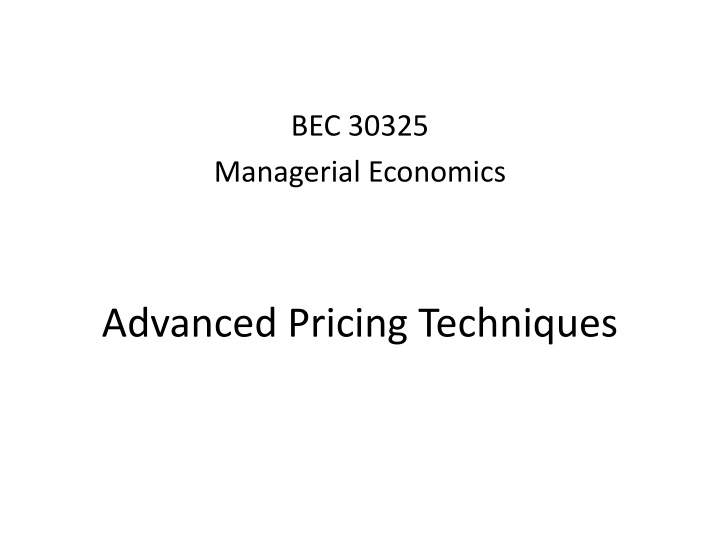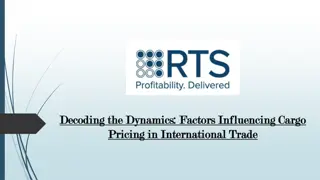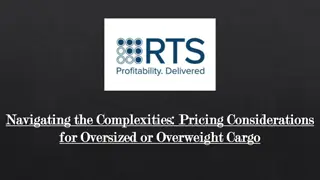
Advanced Pricing Techniques in Managerial Economics
Explore advanced pricing techniques in managerial economics such as price discrimination, capturing consumer surplus, and the challenges of uniform pricing. Learn about perfect price discrimination, second-degree price discrimination, and the conditions necessary for profitable price discrimination practices. Delve into the complexities of pricing strategies and how they impact profitability in different market conditions.
Download Presentation

Please find below an Image/Link to download the presentation.
The content on the website is provided AS IS for your information and personal use only. It may not be sold, licensed, or shared on other websites without obtaining consent from the author. If you encounter any issues during the download, it is possible that the publisher has removed the file from their server.
You are allowed to download the files provided on this website for personal or commercial use, subject to the condition that they are used lawfully. All files are the property of their respective owners.
The content on the website is provided AS IS for your information and personal use only. It may not be sold, licensed, or shared on other websites without obtaining consent from the author.
E N D
Presentation Transcript
BEC 30325 Managerial Economics Advanced Pricing Techniques
Advanced Pricing Techniques Price discrimination Multiple products Cost-plus pricing 2
Capturing Consumer Surplus Uniform pricing Charging the same price for every unit of the product Price discrimination More profitable alternative to uniform pricing Market conditions must allow this practice to be profitably executed Technique of charging different prices for the same product Used to capture consumer surplus (turning consumer surplus into profit) 3
Price Discrimination Exists when the price-to-marginal cost ratio differs between two products: P P A B MC MC A B 5
Price Discrimination Three conditions necessary to practice price discrimination profitably: 1) Firm must possess some degree of market power 2) A cost-effective means of preventing resale between lower- and higher-price buyers (consumer arbitrage) must be implemented 3) Price elasticities must differ between individual buyers or groups of buyers 6
First-Degree (Perfect) Price Discrimination Every unit is sold for the maximum price each consumer is willing to pay Allows the firm to capture entire consumer surplus Difficulties Requires precise knowledge about every buyer s demand for the good Seller must negotiate a different price for every unit sold to every buyer 7
Second-Degree Price Discrimination Lower prices are offered for larger quantities and buyers can self-select the price by choosing how much to buy When the same consumer buys more than one unit of a good or service at a time, the marginal value placed on additional units declines as more units are consumed 9
Second-Degree Price Discrimination Two-part pricing Charges buyers a fixed access charge (A) to purchase as many units as they wish for a constant fee (f) per unit Total expenditure (TE) for q units is: = + TE A fq + TE q A fq = = p Average price ( ) is: p q A q = + f 10
Second-Degree Price Discrimination When consumers have identical demands, entire consumer surplus can be captured by: Setting f = MC Setting A = consumer surplus (CS) Optimal usage fee when two groups of buyers have identical demands is the level for which MRf = MCf 11
Inverse Demand Curve for Each of 100 Identical Senior Golfers 12
Second-Degree Price Discrimination Declining block pricing Offers quantity discounts over successive discrete blocks of quantities purchased 14
Third-Degree Price Discrimination If a firm sells in two markets, 1 & 2 Allocate output (sales) so MR1 = MR2 Optimal total output is that for which MRT = MC For profit-maximization, allocate sales of total output so that MRT = MC = MR1 = MR2 16
Third-Degree Price Discrimination Equal-marginal-revenue principle Allocating output (sales) so MR1 = MR2 which will maximize total revenue for the firm (TR1 + TR2) More elastic market gets lower price Less elastic market gets higher price 17
Profit-Maximization Under Third-Degree Price Discrimination 20
Multiple Products Related in consumption For two products, X & Y, produce & sell levels of output for which MRX = MCX and MRY = MCY MRXis a function not only of QX but also of QY (as is MRY) -- conditions must be satisfied simultaneously 21
Multiple Products Related in production as substitutes For two products, X & Y, allocate production facility so that MRPX = MRPY Optimal level of facility usage in the long run is where MRPT= MC For profit-maximization: MRPT = MC = MRPX = MRPY 22
Multiple Products Related in production as complements To maximize profit, set joint marginal revenue equal to marginal cost: MRJ = MC If profit-maximizing level of joint production exceeds output where MRJ kinks, units beyond zero MR are disposed of rather than sold Profit-maximizing prices are found using demand functions for the two goods 23
Profit-Maximizing Allocation of Production Facilities 24
Cost-Plus Pricing Common technique for pricing when firms do not wish to estimate demand & cost conditions to apply the MR = MC rule for profit-maximization Price charged represents a markup (margin) over average cost: P = (1 + m)ATC Where m is the markup on unit cost 26
Cost-Plus Pricing Does not generally produce profit- maximizing price Fails to incorporate information on demand & marginal revenue Uses average, not marginal, cost 27






















